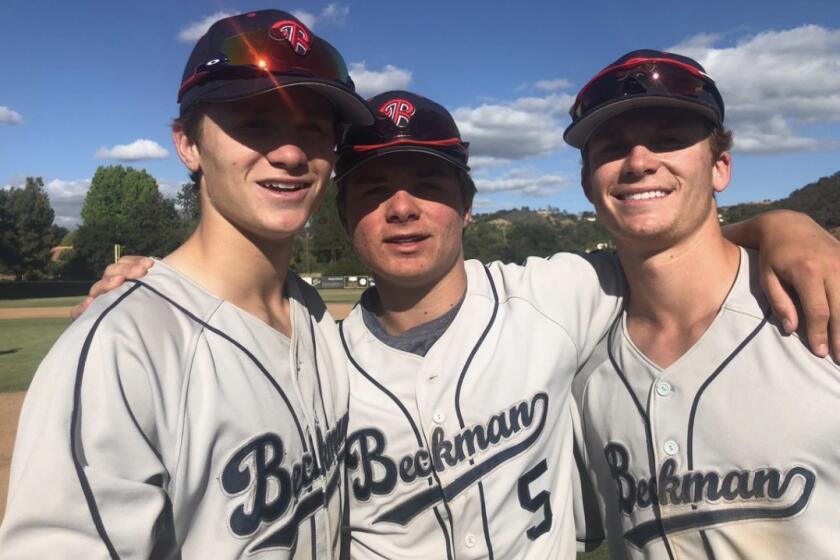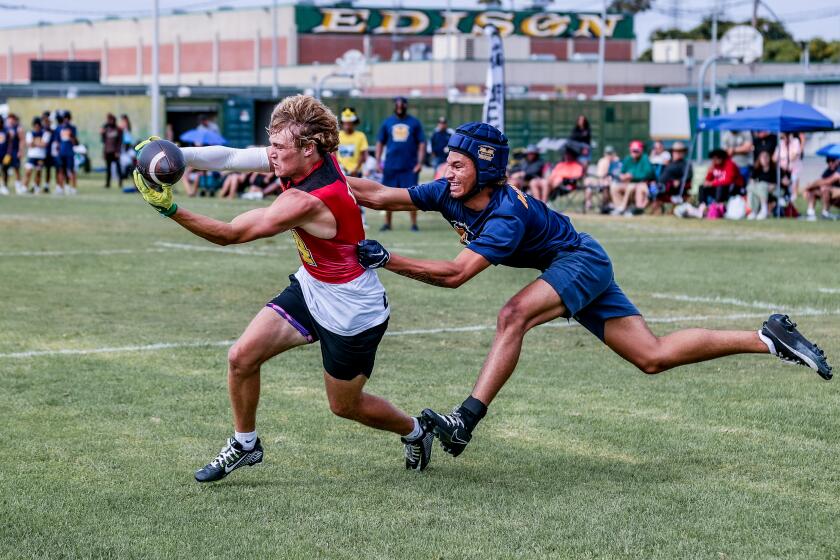IRON LADY : Van Nuys’ Diana Fuhrman, a Compact Combination of Power and Grace, Harbors Long-Term Aspirations for Her World-Class Weightlifting Career
There is nothing remarkable about Diana Fuhrman. She works part time at a health club in Simi Valley. Holds down another job at Royal High. Played the oboe and saxophone for six years. Likes to sew and embroider. Dabbles in photography.
Nothing remarkable at all, really.
Except for the fact that the 5-foot-4 brunette could, with her bare hands, jerk the sink out of your kitchen along with most of the galvanized steel plumbing. And carry it all out the front door. Over her head.
“Oh, and I like watching movies, too,” Fuhrman said. “But I don’t have much spare time to do it.”
You would imagine not, with the two jobs and a five-day-a-week training regimen that basically consists of repeatedly lifting an object that most men would ask a neighbor to help them with.
Fuhrman is a weightlifter. It is a sport for people who grunt a lot and who realize they are getting better at it when their pants don’t fit anymore, their legs having expanded to roughly the size of Vermont.
And, to be honest, when you think of weightlifters, don’t you first think of men? Giant, rotund men? Of course you do.
And if you think of women weightlifters, don’t you think of ladies with first names like Gerd or Samanko, ladies who appear to be a very subtle blend of Al Pacino and Pete Rose? Of course you do.
No high school homecoming queens in this bunch.
Diana Fuhrman, 148 pounds, has lifted more weight than all but three women in her weight class in the world.
And she, as you might expect, was not her high school’s homecoming queen.
She was runner-up.
Long shadows have fallen across the campus of Van Nuys High. Most of the students have departed for the day and it is quiet. Suddenly, the stillness is broken by loud banging. Walking toward the source of the noise, it becomes more distinct. Ka-bang . Clang!
Across a small field and down a set of stairs in the basement of the school, the Van Nuys Weightlifting Club is meeting. Five young men and two young women slap giant plates of steel onto barbells and yank them off the floor to the accompaniment of enormous sounds from their mouths.
When an exercise is over, the barbell with the massive weights is simply dropped from shoulder height onto a plywood platform. Ka-boom!
Along one wall a barbell is hoisted overhead. Twin 33-pound metal plates rest on each end of the bar, with several smaller plates tucked against them. The approximate total, with the weight of the bar, is 170 pounds. Clutching the bar is a small pair of hands with long, perfectly manicured pink fingernails. Just below them is long brunette hair, pulled back tightly into a ponytail, and large, silver hoop earrings that frame a pair of deep, brown eyes.
The body is covered with flashy black and pink tights, a pink sweat shirt and black weightlifter’s shoes, shoes with built-up heels and rounded toes.
The exercise is over now, and the bar crashes down onto the plywood deck. The floor shakes.
“Yow,” says Fuhrman, sharply.
The yow was not caused by the barbell falling on her toes. It was, simply, a yow of relief. There would be another lift in about a minute or so, and many more after that. But for a moment, she could rest. The training session would stretch well into the night, ending only when her muscular but slim arms and shoulders and muscular but not slim legs trembled from the exertion.
She would come back again to the small, dusty room with the glaring light bulbs and flaking paint the next night. And the next. And just maybe, every night until 1996, when women’s weightlifting could make its Olympic debut.
“In the back of my mind, that’s what I think about,” said Fuhrman, 26. “I know it’s a long way off, but that is the ultimate. If we get some reassurance in the near future that weightlifting is set for the 1996 Olympics, I just might make it.”
In the meantime, there are state and national and world championships in which to compete.
In the 1988 Women’s World Weightlifting Championships in Jakarta, Indonesia, Fuhrman finished fourth in the 67.5-kilogram weight division, or 148.5 pounds.
In the snatch, which requires that the bar be lifted overhead in one unbroken movement, she lifted 170.5 pounds. In the clean and jerk, in which the bar is first brought to the shoulders and then pushed overhead, Fuhrman lifted 225.5 pounds.
To put this in practical terms for those who don’t routinely lift such loads, try this: Find your 225-pound Uncle Lou. Knock him down and put one of your hands under his knee and the other around his neck. Then jerk him off the floor and hold him still for a few seconds above your head.
It wasn’t really easy, was it?
For her effort in the world championships, Fuhrman finished behind China’s Guo Qiuxiang and Maria Takacs of Hungary. She was tied for third with Janet Rose of Great Britain, losing that place because she weighed a few ounces more than Rose.
She was not satisfied.
“I expected to do much better,” she said. “I thought I would place second. I had programmed myself for a certain lift, and I didn’t make it. I had worked for and completed lifts of 87.5 kilos (192.5 pounds) in the snatch and 112.5 kilos (247.5 pounds) in the clean and jerk. I had done both of them in the world trials in Houston.”
Fuhrman, who has a degree in kinesiology from Cal State Northridge, said that she was unable to focus and gather the initial burst of energy required to take the bar off the mat. A well-meaning but boisterous crowd in Jakarta kept up a deafening roar of approval when she squatted to prepare for her lifts, a moment when silence is expected from the spectators. And, she said, she was lost without her regular coach, Bob Takano of Van Nuys. International weightlifting meets are similar to the Olympics, with team coaches appointed by the national federations.
“Without Bob, I never felt right,” Fuhrman said. “The other coach didn’t know me, didn’t know what I needed. I needed to be left alone before the lifts, and he stayed at my shoulder, screaming things like, ‘You need this one for second place, get fired up,’ things like that. I just couldn’t channel my energy.
“I still finished fourth in the world, but I know I can do better.”
Ten years ago, when Takano--a biology teacher at Van Nuys High--watched a skinny, 15-year-old Fuhrman run the hurdles for the school’s track team and also play tennis, he, too, knew she could do better. A longtime teacher of weightlifting who has taught a course at UCLA on the subject, Takano told Fuhrman that he could help improve both her hurdling and tennis.
But, he now admits, he had a loftier goal for Fuhrman.
“I told her weightlifting would make her better at the sports she was already involved in, but deep down I knew she would make a great weightlifter,” Takano said. “She had the perfect body--short arms and legs--and great quickness and explosiveness, things that are essential in weightlifting.
“But I also saw that unlike most girls, Diana had a sports mentality, a real desire to beat people in sports.”
Fuhrman began lifting in the 123-pound category but found only moderate success. Her problem, Takano told her, was a simple one: She had to gain considerably more weight. More than 20 pounds.
That is not what most pretty, boy-crazy, teen-age girls think of as a great idea. Throughout high school and several years beyond, Fuhrman fought Takano on the weight issue.
“Weightlifters need weight, lots of weight,” Takano said. “The torso serves as something to rest your appendages on when you lift. If more of your arm is resting against your torso, you’ll be able to lift more weight.”
This is the explanation for why world-class weightlifters, especially the men, are indeed fat. The man generally acknowledged as the greatest lifter of all, the Soviet Union’s Vasily Alexeyev, had an enormous stomach that hung below his his waist and a massive, flabby chest.
The power comes from the legs and lower back.
“I just couldn’t do that,” Fuhrman said. “I was serious about weightlifting, even in high school, but I just couldn’t make myself gain all that weight. There were other things more important. There were dances and the homecoming thing and high-heeled shoes and short skirts and and all of that.”
But after graduating, she decided to give Takano’s theory a chance. She began to gain weight, eating huge amounts of food at all hours of the day. To her surprise, she didn’t block out the sun. With the brutal training sessions, the bulk and strength in her lower back and legs increased dramatically.
But, she retained . . . well, let her tell it:
“I still have a waist and boobs,” she said.
And she still has a dream.
“Early in my involvement with weightlifting, I saw that I had a real chance at being the best in the nation, maybe the best in the world at something,” Fuhrman said. “It’s not something that we get a lot (of), or any, recognition for. We don’t attract crowds most of the time and we don’t get sponsors and we don’t make any money at all, but still, I had the chance to be the very best in a sport.
“The idea of being able to reach that high really amazed me. If the Olympics come along, that’s great. But even if they don’t, I’ll continue lifting for quite a while.
“The 1989 world championships are in China in November, and I’ve got some unfinished business.”
Get our high school sports newsletter
Prep Rally is devoted to the SoCal high school sports experience, bringing you scores, stories and a behind-the-scenes look at what makes prep sports so popular.
You may occasionally receive promotional content from the Los Angeles Times.



